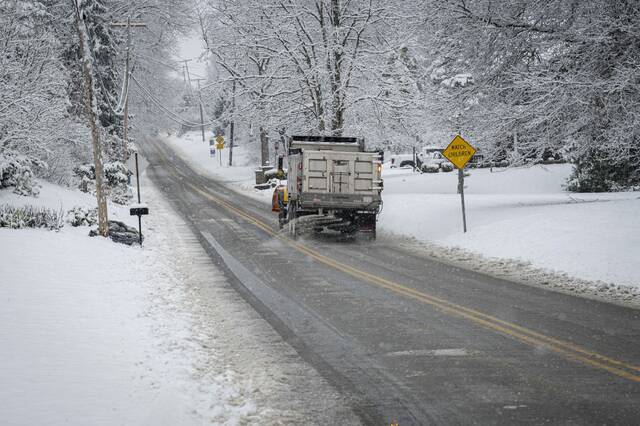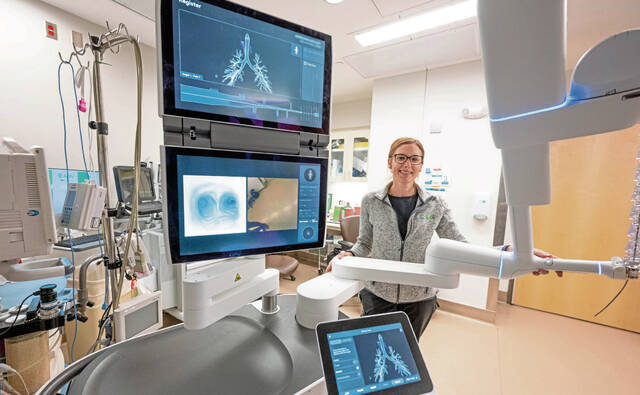When Thomas Shea had to quarantine in October, he never stopped teaching. From his home, he continued giving and recording lessons for his 10th-grade social studies students at Kiski Area High School.
Shea said about two-thirds of his students are still learning from home, though the school district offers up to four days of in-person instruction. A co-teacher watched the students in his classroom, Shea said, but he still carried out his lessons from afar, with students following along on their Chromebooks.
“It’s changed,” Shea said. “Covering classes isn’t new for teachers. It’s something we usually have to do here and there, a couple times a month. … But now, when it’s a teacher who is quarantined, they’re still managing the class.”
Educators had predicted early in the pandemic that increased covid cases would amplify a shortage of teachers and substitutes. Months later, many districts have found hybrid and remote learning offers a bit more flexibility. Still, many educators also have found the shortage is more challenging to manage, as quarantines take teachers out of class and create inconsistency for students and an added burden for schools hoping to reopen for full face-to-face learning.
“It’s exacerbated what was a problem even before the pandemic,” said Robert Scherrer, executive director of the Allegheny Intermediate Unit.
Scherrer said the number of teaching certificates issued in Pennsylvania has dropped by 74% in the past eight years, resulting in a “tremendous reduction” in the number of people going into education, shrinking the pool of both full-time and substitute teachers.
And it’s not just teachers — custodians, school nurses, paraprofessional aides and other important support staff are a limited commodity across the state. During the pandemic, when unexpected quarantines can take people out of buildings for up to two weeks, the absence of adequate staff levels can create more work for remaining employees already juggling the increased workload of hybrid learning.
“It’s trying to find bodies in cases where people have had to quarantine,” said Gary Peiffer, superintendent of Greensburg Salem School District, who noted there are often more people who need to quarantine than there are actual positive cases.
Peiffer said the substitute fill rate at Greensburg Salem is about 89% — not normally an issue. But amid the shifts from hybrid to remote learning, coordinating absences and subs can get hectic. Peiffer said he’s found himself trying to fill spots for school nurses, paraprofessional aides and custodians.
The remote and hybrid schedule the district offers ended up being helpful, he said, because many of the teachers quarantining can still work with students from home. In other cases, such as with custodian absences, other people have had to pick up the work.
Shuffling students and staff during a pandemic is an added challenge because of social distancing requirements, Shea said. While he had a co-teacher and teaching assistant able to be in the room with his students while he was out, he knows that’s not the case in every district.
“Now you have students in the building that might have to go to another class,” he noted. “That’s increasing the number of students in a classroom beyond what we want to have.”
The shortage has been especially challenging for specialty areas, including the advanced sciences, world languages and special education. James Palmiero, the AIU’s assistant executive director for special education and pupil services, said the three AIU-operated special education schools — Sunrise School, Pathfinder School and Mon Valley School — long have had difficulties maintaining an adequate supply of substitute teachers.
Each year, Palmiero said, the AIU hires substitutes for the year, and they remain on staff.
“We know how many building base substitutes we need in order to keep the buildings stable and address teacher absences,” Palmiero said. “However, we have never been able to fill all of those vacancies for those positions, because there just aren’t enough candidates.”
Palmiero said the vacancies always have been “interruptive” to the educational process for students with special needs, as well as for the teachers themselves. Other teachers in the schools may have to step in and fill in for one another during their planning times.
“It’s very disruptive to students — especially to students who thrive on that sense of predictability in their learning space,” Palmiero said.
During the pandemic, as the three schools have stayed open for face-to-face instruction for the 2020-21 school year, there has been even more disruption. If a teacher has a possible covid exposure, they must quarantine for about 10 days, if not longer. The pandemic has created even more of a demand for the few substitute teachers the schools have available.
Educators say the shortage has created more competition among school districts, hiring substitutes at more competitive rates. Several use emergency certifications, permits that are issued by the state Department of Education that allow individuals to serve in day-to-day or longer-term substitute positions.
“It goes back to how do we increase the pipeline? How do you attract more folks, younger individuals, going to college wanting to become teachers? It is certainly a difficult position but just a tremendously rewarding career. We need to highlight that,” Scherrer said. “I think the last year has shown the power of educators to connect with kids, to support families. We need to build on that and show this is an option for folks who really want to help shape and mold the future citizens that are going to be running our country.”
Several educators said they think the developments in remote learning in the last year will create more flexibility for districts in the long-term.
“If you want to make attractive for people coming into the field, it has to be dynamic,” Peiffer said. “It has to be forward-thinking of how we can best serve students.”








